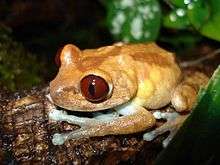Arthroleptidae
The Arthroleptidae /ˌɑːrθroʊˈlɛptɪdiː/ are a family of frogs found in sub-Saharan Africa. This group includes African treefrogs in the genus Leptopelis along with the terrestrial breeding squeakers Arthroleptis, and several genera restricted to the Guinean forests of central and west Africa, such as the hairy frog (Trichobatrachus).
| Arthroleptidae | |
|---|---|
 | |
| Leptopelis uluguruensis | |
| Scientific classification | |
| Kingdom: | Animalia |
| Phylum: | Chordata |
| Class: | Amphibia |
| Order: | Anura |
| Clade: | Afrobatrachia |
| Family: | Arthroleptidae Mivart, 1869 |
| Genera | |
|
See text | |
Taxonomy
This family is the phylogenetic sister group of reed frogs, the Hyperoliidae, which together form the lineage Laurentobatrachia,[1] a name that commemorates work on African frogs by the Argentine herpetologist Raymond Laurent. This group is further nested within the Afrobatrachia, an ancient African endemic lineage that includes the Brevicipitidae and Hemisotidae.[1] The Arthroleptidae are separated, based on phylogenetic analyses, into three deeply divergent and dissimilar subfamilies: Arthroleptinae, Astylosterninae, and Leptopelinae.[2][3] Some consider these to be separate families,[4] while others do not recognize any subfamilies, in particular due to uncertainty in the phylogenetic placement of Leptopelis and Scotobleps.[5][6]
The three subfamilies consist of these genera:[3]
| Subfamilia | Species | Common name | Scientific name |
|---|---|---|---|
| Arthroleptinae Mivart, 1869 |
48 | Screeching frogs | Arthroleptis Smith, 1849 |
| 19 | Long-fingered frogs | Cardioglossa Boulenger, 1900 | |
| Astylosterninae Noble, 1927 |
12 | Night frogs | Astylosternus Werner, 1898 |
| 15 | Egg frogs | Leptodactylodon Andersson, 1903 | |
| 1 | Southern night frog | Nyctibates Boulenger, 1904 | |
| 1 | Gaboon forest frog | Scotobleps Boulenger, 1900 | |
| 1 | Hairy frog | Trichobatrachus Boulenger, 1900 | |
| Leptopelinae Laurent, 1972 |
54 | Forest treefrogs | Leptopelis Günther, 1859 |
References
- Frost, Darrel R; Grant, Tarrant; Faivovich, Julian; Bain, Raoul H; Haas, Alexander; Haddad, Celio FB; De Sa, Rafael; Channing, Alan; Wilkinson, Mark; Donnellan, Stephen C; Raxworthy, Christopher J; Campbell, Jonathan A; Blotto, Boris L; Moler, Paul; Drewes, Robert C; Nussbaum, Ronald A; Lynch, John D; Green, David M; Wheeler, Ward C (2006). "The Amphibian Tree of Life". Bull. Am. Mus. Nat. Hist. (297): 370pp.
- Pyron, RA; Wiens, JJ (2011). "A large-scale phylogeny of Amphibia including over 2800 species, and a revised classification of extant frogs, salamanders, and caecilians". Molecular Phylogenetics and Evolution. 61: 543–583. doi:10.1016/j.ympev.2011.06.012. PMID 21723399.
- Frost, Darrel R. (2014). "Arthroleptidae Mivart, 1869". Amphibian Species of the World: an Online Reference. Version 6.0. American Museum of Natural History. Retrieved 4 July 2014.
- Bossuyt, F; Roelants, K (2009). Hedges, SB; Kumar, S (eds.). Anura. New York, USA: Oxford University Press. pp. 357–364.
- Blackburn, David C. "Family Arthroleptidae". AmphibiaWeb. University of California, Berkeley. Retrieved 23 July 2015.
- Blackburn, D.C.; Wake, D.B. (2011). "Class Amphibia Gray, 1825. In: Zhang, Z.-Q. (Ed.) Animal biodiversity: An outline of higher-level classification and survey of taxonomic richness" (PDF). Zootaxa. 3148: 39–55.
^ *" 'Horror frog' breaks own bones to produce claws." NewScientist.com, 2008
Further information
- ADW: Arthroleptidae: Information
- Cogger, H.G.; R.G. Zweifel; D. Kirschner (2004). Encyclopedia of Reptiles & Amphibians Second Edition. Fog City Press. ISBN 1-877019-69-0.